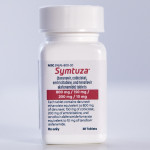People who rapidly start Symtuza (darunavir/cobicistat/tenofovir alafenamide/emtricitabine) following an HIV diagnosis have a high rate of viral suppression a year later.
Janssen’s Symtuza was approved in July 2018 for those starting antiretroviral treatment for the first time as well as certain people switching from a different regimen who have a fully suppressed viral load.
Presenting their findings at the 13thAnnual American Conference for the Treatment of HIV in Miami, researchers from the Phase III single-arm, open-label, prospective multicenter 48-week DIAMOND study evaluated the safety and efficacy of rapidly staring participants on Symtuza. A total of 109 participants were enrolled in the study within 14 days of diagnosis and then started on treatment before the results of their initial round of laboratory or viral resistance tests were available.
Twenty-four week findings were presented at the International AIDS Conference in Amsterdam (AIDS 2018) in July 2018.
This is the first prospective Phase III trial studying the rapid initiation of a single-tablet regimen.
At the 48-week mark, 89 percent (97 of 109) of the participants were still enrolled in the study. Eighty-four percent (92 of 109) had a fully suppressed viral load while 8 percent (9 of 109) had virological failure, defined as experiencing a viral load of at least 50.
Excluding the participants about whom there were missing data, 96 percent (92 of 96) had a fully suppressed viral load after 48 weeks, and 100 percent (96 of 96) had a viral load below 200. None discontinued Symtuza because of lack of efficacy.
The regimen was well tolerated. None of the participants experienced serious adverse health events related to treatment. Most of the adverse health events were grade 1 or 2 in severity. Two people experienced a grade 3 drug-related adverse health event, one of whom stopped treatment because of adverse health events.
The most common adverse drug reactions related to Symtuza experienced by at least 2 percent of the participants were diarrhea, nausea, rash, vomiting and fatigue. Grade 3 and 4 laboratory abnormalities that occurred in at least 2 percent of participants included increases in AST liver enzymes (5 percent of participants experienced this), ALT liver enzymes (3 percent) or bilirubin (3 percent).
Ninety-seven percent of the participants reported that they were satisfied with their treatment.
To read a press release about the study, click here.







Comments
Comments